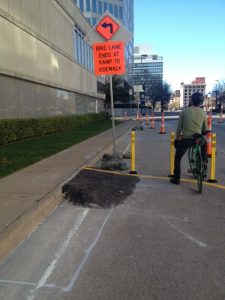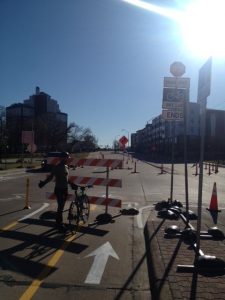Finally, a buffered bike lane between Oak Cliff and downtown. It is a little surreal to cross the river on a bike without fear of being hit from behind, swerved into, sideswiped. “Less death-y,” as I like to call it. And this new cycle track is a lot less death-y for cyclists compared to the previous traffic configuration.
Bicycle commuter Scott Yokel rode across the reconfigured Jefferson Street Viaduct with me Monday. It’s not perfect. The lanes’ entrances and exits are abrupt and awkward. When we arrived at the entrance from Zang, as the picture at left shows, a barrier had been placed in the middle of the bike lanes. The bike lane jogs here so that a cyclist entering the bridge from Zang must stop and make a left turn across car traffic.
On the other side of the bridge, the ingress/egress is slapped together.  The bike lane ends about 50 feet before Young Street. The sign pictured at right says, “Bike lane ends at ramp to sidewalk.” Interesting, Yokel noted, since riding a bike on the sidewalk is not allowed downtown.
The bike lane ends about 50 feet before Young Street. The sign pictured at right says, “Bike lane ends at ramp to sidewalk.” Interesting, Yokel noted, since riding a bike on the sidewalk is not allowed downtown.
But let’s say we ride on the sidewalk to Young, then where to go? Turning right onto young is too dangerous because of all the traffic being diverted from Houston Street and turning right onto the Jefferson bridge. So from the sidewalk at Young, you can only go forward on Market Street, and you’re in the left lane. It is not ideal. The ingress/egress needs work on both sides.
The city created two-way car lanes and a two-lane cycle track on the bridge in one weekend. We wondered why it wasn’t done long ago. The Jefferson Viaduct was built in 1973 with about 25,000 cars a day in mind; 40 years later, the daily count is about 6,000. In the bridge’s new configuration, traffic moves slower, and it’s safer for cyclists, at least crossing the bridge. Just please be careful, everyone, where the cycle track ends.






